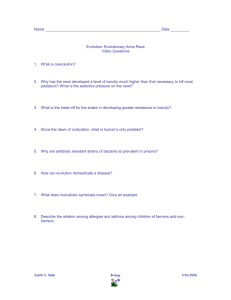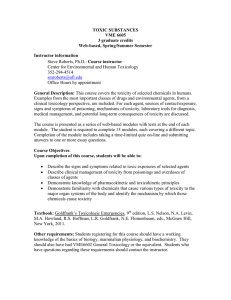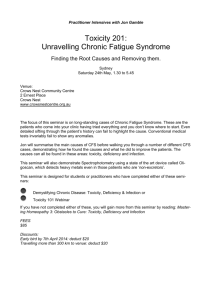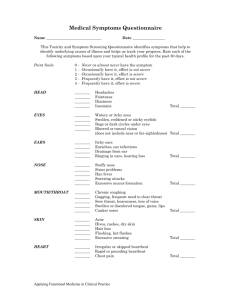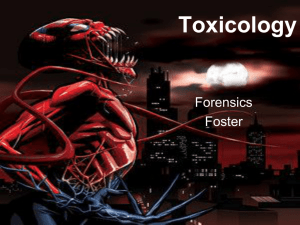Investigating the Toxicity of Oxygenated Polycyclic Aromatic Hydrocarbons (OPAHs) in Developing Zebrafish
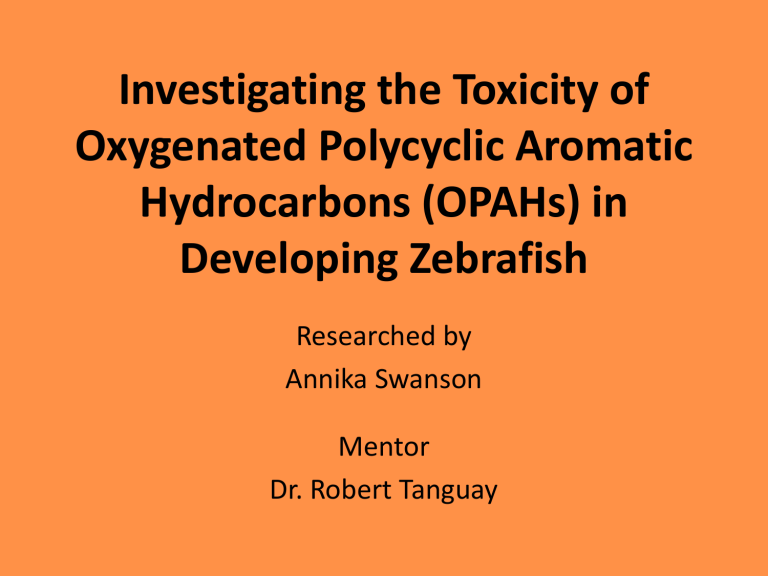
Investigating the Toxicity of
Oxygenated Polycyclic Aromatic
Hydrocarbons (OPAHs) in
Developing Zebrafish
Researched by
Annika Swanson
Mentor
Dr. Robert Tanguay
PAHs
• Polycyclic aromatic hydrocarbons
– 2 or more rings
– Named by functional groups
Naphthalene http://www.sigmaaldrich.com
PAHs
• Environmental contaminants
– Carcinogenic
– Mutagenic
– Teratogenic
• PAH production
– Automobile exhaust
– Industry emissions
– Wood burning
– Tobacco smoke http://www.platinum.matthey.com
OPAHs
• Oxygenated polycyclic aromatic hydrocarbons
• PAHs with oxygen additions
– Functional groups
– Carbonyl, hydroxyl, carboxyl http://chemed.chem.purdue.edu/genchem/topicreview/bp/2organic/carbonyl.html
OPAH Formation
• Incomplete combustion processes
• Transformation of PAHs
– Chemical oxidation
– Photo-oxidation
– Biological/microbial transformation
Bacteria Degradation of Naphthalene http://www.mdpi.com/1660-4601/6/1/278/htm
Research Objectives
• Analyze the toxicity of OPAHs in developing zebrafish
– AHR activation
– CYP1A induction
– Molecular structures
• Expand the limited scientific knowledge about
OPAH toxicity
• Zebrafish
• Development and toxicity
The AHR Pathway
AHR Ligand
• Three
Zebrafish
AHR receptors
– AHR2 (liver, vasculature)
– AHR1B
(vasculature)
– AHR1A (liver)
AhR
AhR
ARNT
Cytoplasm
AhR
ARNT
Nucleus
AhR
ARNT
DRE
Transcription of genes
CYP1A
Translation
• CYP1A protein expression
•
Xenobiotic metabolism
Experiment Setup
• Dechorionate embryos
• Expose to the chemical in solution
• Make 24 hour and 5 day evaluations
• Fix for IHC analysis
Stages of Development
3 min
19 hr
1.25 hr
48 hr
4 hr
24 hr
5 day
6 hr
9,10-Phenanthrenequinone
Five Day Observations
1% DMSO (Control)
2.0μM PQO in 1% DMSO
Immunohistochemistry
• IHC
– Tag CYP1A protein http://www.badrilla.com/ihc.html
IHC
10 µM Leflunomide 25 µM Benz(a)anthracene
Positive Controls (Vehicle: 1% DMSO)
Negative Control (1% DMSO)
Results
9,10-Phenanthrenequinone (PQO)
• C
14
H
18
O
2
• Toxic chemical in diesel exhaust emissions (DEP)
• Quinone Toxicity
1.6µM http://www.sigmaaldrich.com
• C
14
H
8
O
2
• Quinone
9,10-Anthraquinone
Toxicity
20µM http://en.wikipedia.org/wiki/File:Anthraquinone_acsv.svg
Xanthone
• C
13
H
8
O
2
• Very little information known
20µM
Toxicity http://en.wikipedia.org/wiki/File:Xanthone.svg
1,9-Benz-10-anthrone (BAO)
• C
17
H
10
O
• Very little information known
Toxicity
20µM http://www.sigmaaldrich.com
Benz[a]anthracene-7,12-dione (BADO)
• C
18
H
10
O
2
• Quinone
Toxicity
5µM http://www.sigmaaldrich.com
AHR2 Knockout
• 5µM Benz[a]anthracene-7,12-dione (BADO)
Wild-type Fish AHR2 Knockout Fish http://learn.genetics.utah.edu/content/labs/pcr/
2,3-Dihydroxynaphthalene
• C
10
H
8
O
2
• 2-ring, more volatile
• Strong unique CYP1A expression
Toxicity
20µM http://www.sigmaaldrich.com
Experiment
• Polymerase Chain Reaction
• (PCR)
• Gene expression changes
• qPCR http://learn.genetics.utah.edu/content/labs/pcr/
Experiment
• Quantitative PCR
• Gene expression differences between products
CYP1A (5dpf)
140
120
100
80
60
40
20
0
0.1%_DMSO OPAH7_5uM OPAH10_20uM OPAH17_1uM OPAH20_20uM OPAH21-5uM BKF_10uM
Sample
Structural Dependence of OPAH
Toxicity
Toxicity
5µM
Benz[a]anthracene-7,12-dione (BADO)
Toxicity
1,9-Benz-10-anthrone (BAO)
10µM
9,10-Phenanthrenequinone (PQO)
2µM
9,10-Anthraquinone
20µM
Xanthone 20µM
Toxicity
Toxicity
Toxicity
Conclusion
• Oxygenated polycyclic aromatic hydrocarbons
– Toxic compounds
– Structural relationships
– Present in environment
• Future
– 2-ring OPAHs
– Injections into chorion
Acknowledgements
• Howard Hughes Medical Institute
• URISC
• Oregon State University Honors College
• CRIPPS
• Dr. Robert Tanguay and Lab
• Britton Goodale and Andrea Knecht
• Dr. Kevin Ahern

